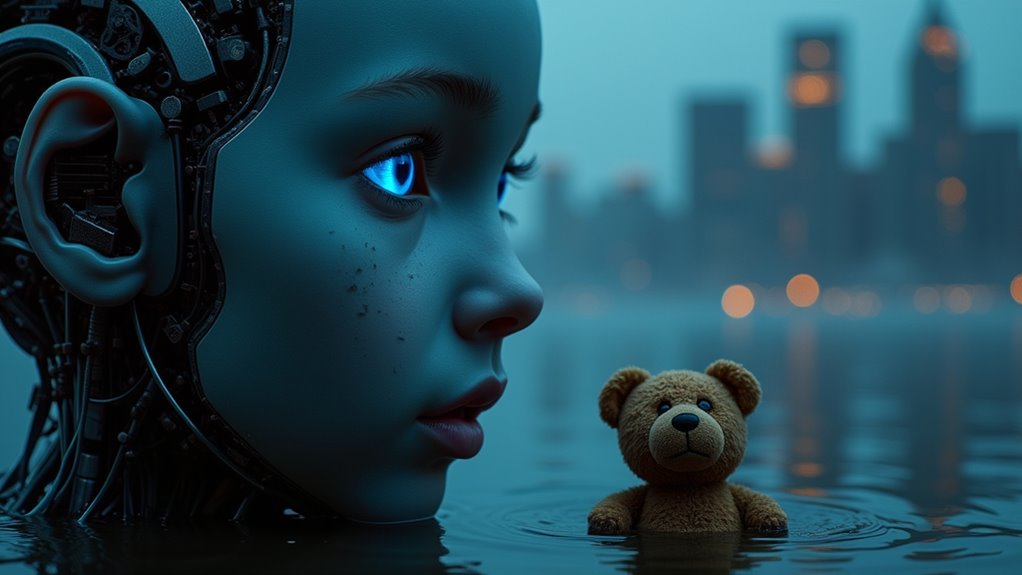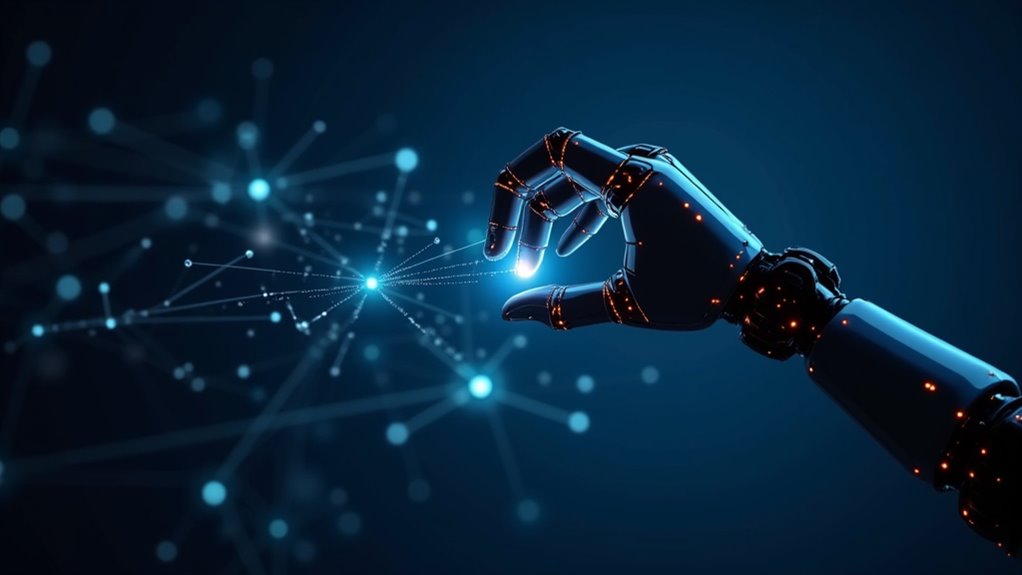A.I. Artificial Intelligence (2001) blends Kubrick’s vision with Spielberg’s direction in a haunting tale of David, a robot child programmed to love. Set in a flooded 22nd-century world, it follows David’s quest to become human after being abandoned by his adoptive family. The film tackles profound questions about AI ethics, the nature of consciousness, and our responsibility to sentient machines. Its emotional impact and visual mastery make this sci-fi meditation more relevant today than ever. Prepare for existential questions you never knew you needed answered.

The film thrusts viewers into the 22nd century, where coastal cities lie submerged and climate patterns have dramatically shifted. At its core, the story explores robot ethics through David, a childlike android programmed with emotional intelligence and the capacity to love. When David’s adoptive family abandons him after their biological son returns home, the android initiates a heartrending quest to become human.
In a drowned world of tomorrow, a child-robot yearns for humanity after being cast aside by the family he loves.
You’ll find yourself questioning what truly separates artificial feelings from authentic ones – and whether that distinction even matters. David’s journey alongside his faithful companion Teddy (a robotic bear) takes him through harrowing experiences, including the notorious Flesh Fair where obsolete robots face destruction.
The relationship between humans and machines is laid bare, forcing you to confront uncomfortable truths about our technological future. Could you abandon a machine that genuinely loves you?
Originally conceived by Kubrick over a decade-long development process, Spielberg ultimately directed the film after Kubrick’s passing, adding his characteristic warmth to the narrative. This collaboration produced what many consider one of Spielberg’s finest works and among the greatest films of the 21st century, ranking eighty-third in a 2016 BBC poll of films since 2000. The film features impressive visual effects that required removing visible breath from Osment during cold weather scenes to maintain the illusion of his robotic nature.
The film’s legacy continues to shape discussions about artificial intelligence development. As we race toward creating increasingly sophisticated AI systems, *A.I. Artificial Intelligence* serves as both warning and meditation on the ethical implications of programming emotions into machines. The narrative strikingly anticipates modern concerns about algorithmic bias and the ethical frameworks needed for responsible AI development. Audiences often experience strong emotional responses to David’s story, drawing them into deeper reflections about empathy toward non-human entities.
What responsibilities do we bear toward the sentient technology we create? Spielberg’s film doesn’t provide easy answers – it simply guarantees we ask the right questions.
Frequently Asked Questions
Was A.I. Originally a Stanley Kubrick Project?
Yes, “A.I.” was indeed Kubrick’s vision initially. The legendary director acquired the rights to Brian Aldiss’s story “Supertoys Last All Summer Long” in the early 1970s and developed it for nearly three decades.
Technological limitations kept delaying production, particularly for creating a realistic android child.
In 1995, Kubrick handed the project to Spielberg, who ultimately directed it after Kubrick’s death. The final film blends both directors’ approaches to AI themes.
How Did Spielberg Change Kubrick’s Original Vision?
Spielberg transformed Kubrick’s colder, philosophical vision through several creative differences.
He infused the story with warmer emotions and more accessible character development—classic Spielberg moves!
The thematic shifts were significant; while Kubrick would likely have explored existential questions with clinical detachment, Spielberg emphasized love, abandonment, and the quest for humanity.
The ending became more definitive and emotionally satisfying, trading Kubrick’s probable ambiguity for closure that audiences could connect with on a personal level.
What Inspired Haley Joel Osment’s Performance as David?
Osment’s preparation for portraying David drew heavily from Pinocchio, mirroring the quest to become “real.” His father Eugene provided essential support during filming, while Spielberg’s guidance helped shape the character’s emotional depth.
The 12-year-old actor deliberately incorporated subtle robotic mannerisms that gradually evolved throughout the film. Want to know his secret? Osment focused intensely on facial expressions and vocal control to convey David’s artificial nature while still making audiences genuinely care about a machine’s journey toward humanity.
Did the Film Use Practical Effects or CGI?
The film masterfully employed both practical effects and CGI techniques, creating a seamless visual experience.
Practical effects built tangible props, detailed costumes, and lifelike animatronics for robot characters like David. Meanwhile, ILM handled the digital side, developing impressive CGI for futuristic environments and underwater scenes.
The magic happened when these approaches merged—think David’s intricate facial expressions combining animatronic design with digital enhancements.
This hybrid approach wasn’t just visually stunning; it helped blur the line between human and machine.
Why Was the Ending Controversial Among Viewers?
The ending sparked heated debate for several reasons. Critics were split over its ambiguous conclusion, with some viewers finding the emotional impact powerful and others dismissing it as overly sentimental.
The clash between Kubrick’s typically darker vision and Spielberg’s more hopeful approach created a stylistic disconnect that bothered purists. Additionally, the post-apocalyptic final act felt tonally jarring to many, while others appreciated its complexity.
Love it or hate it, nobody watches that ending without feeling something.









